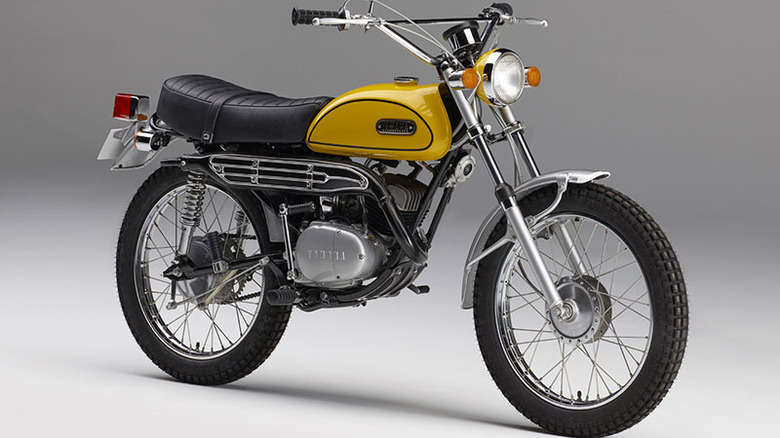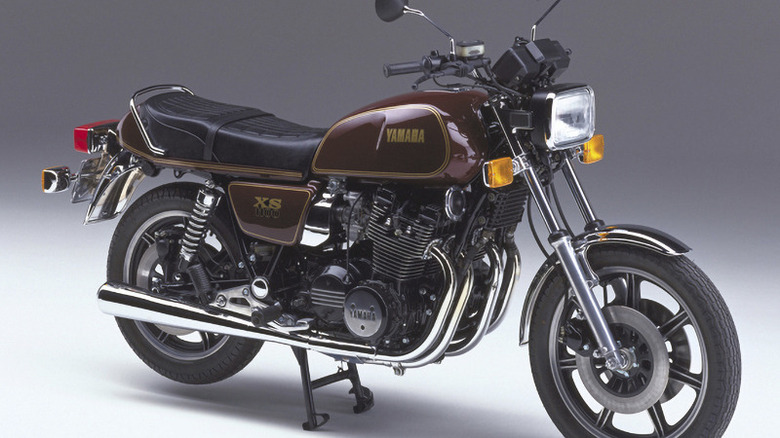5 Legendary Yamaha Motorcycles From The 1970s
Yamaha's origins reach back to 1887, when founder Torakusu Yamaha repaired an elementary school's pipe organ. He built one of his own soon afterwards, and began making upright pianos at the turn of the century. The Yamaha Motor Company was established in 1955, and produced the YA-1 that same year. Yamaha began exporting bikes to the United States in 1958, and by the end of the following decade, motorcycles were becoming a phenomenon in the U.S. The biker flick "Easy Rider," starring Jack Nicholson, Peter Fonda, and Dennis Hopper was a sensation in 1969, and that same year Honda kick-started the superbike era with the releases of the CB750 and CR750.
Motorcycle design and development took off in the 1970s, with manufacturers racing to produce more powerful engines, better-looking models, and bikes everyone could ride. Yamaha's best models ever span a period of over 50 years from the YA-1 through the 20th century, but we're going to focus on the five most important Yamaha bikes from the 1970s. Many represented technological breakthroughs, some had historical significance, and others earned spots on this list by enduring in the hearts of riders for half a century.
The RD350 was at its best on twisty roads
Yamaha's RD350 is a true highlight from the two-stroke era. Its 347 cubic centimeter twin-cylinder two-stroke engine made 39 horsepower worth of blue smoke, not enough to keep pace with the era's fastest bikes in a straight line. But the R350 excelled on curves, thanks to the near-perfect handling and reed valve architecture that gave it a broad torque curve. The RD350 was also affordable; the 1974 model cost just $908, which inflates to just a little over $6,100 in 2024 dollars.
The thirsty engine gobbled gas at the rate of about 26 miles per gallon in spirited riding, but Motorcyclist reviewed the 1974 RD350B and found that "in everything but all-out acceleration, the Yamaha 350 will probably outperform just about anything on the market in box-stock trim." Many RD350s were modified well beyond stock, and the right combination of upgrades could boost output past the 50-horsepower mark. Roland Brown of Hagerty UK called the RD350, "the best bike of the '70s," thanks to the peppy air-cooled twin and purposeful design. You can still find RD350s for $3,500 or less, although a handful in excellent condition have sold for $10,000 or more in recent years.
The HT-1 was a first bike for many riders in the '70s
A few of Yamaha's most important 1970s models weren't meant to spend all their time on paved roads. The HT-1 was an enduro bike with an 89 cubic centimeter single-cylinder engine that emitted a satisfying and surprisingly throaty gurgle. It made horsepower and torque numbers in the single digits, which made the HT-1 an ideal starter bike for many '70s teenagers. The sub-200 pound dry weight made it easy to wrangle, and in you could buy a 1970 model for the equivalent of less than $300 (a little more than $2000 in today's money).
That price was just about within reach of anyone with a paper route, and the knobby tires on 18-inch wheels and almost nine-inch ground clearance made it perfect for cruising rugged trails. Many of the preteens and teens that rode HT-1s grew up to own bigger, badder bikes. One of them was Geoff Drake, who went on to write for Rider Magazine. "It was the obsessive object of late nights in the garage when I was 12," he recalled, "the one from which all the madness sprung — the catalyst for broken bones, busted bank accounts and bad habits."
The XT500 was a Paris-Dakar Rally champion
For HT-1 riders who were ready for something bigger by the middle of the decade, Yamaha designed and built the XT500. It was released in 1976, with a price of about $1200. It was the street-legal variant of the enduro racer TT500, and was the first off-road motorcycle to use a forward-leaning upside-down rear suspension. The XT500 was popular among riders in the nascent years of the Paris-Dakar Rally, and Cyril Neveu won the first two events in 1978 and 1979 with one beneath him.
The overhead-cam four-stroke 499cc single-cylinder engine produced 32 horsepower, and the engine's 87 millimeter bore and 84 millimeter stroke and prominent cooling fins gave it an imposing presence just inside the frame's leading edge. It was light enough to make wheelies easy, and was remarkably easy to maintain. It's also earned a reputation for reliable operation over the years, in racing and road settings alike.
DIrt riders love the YZ250
Yamaha's YZ250 was born in the '70s but has enjoyed a long and fruitful run through the 2025 model year. This motorcross legend has stuck true to its two-stroke roots, winning multiple off-road championships along the way. It was developed by motocross family patriarch Don Jones in his California workshop. Jones raced as a young man and was the father of racers DeWayne and Gary Jones, the latter of whom won the 250cc championship four times. Don designed the first YZ250 as a version of the DT-1, and the bike he built won the first American Motorcyclist Association motocross title with Gary on board. Yamaha then took that bike back to Japan and built the production version of the YZ250 from Jones' template. Rumor has it that Jones scrawled "A2Z" on the prototype's gas tank, to let Yamaha know that everything from A to Z had been modified from the DT-1 he started with. The DT-1 had evolved from the Trailmaster and YX26 and debuted in 1967.
The production YZ250 outlived Don and DeWayne Jones. DeWayne died in 2016, and Don in 2021. The YZ250 has stayed in Yamaha's lineup since the '70s, and the 2025 version starts at $7,999 plus a $600 destination charge. It's the last Japanese-made production bike with a two-stroke 250cc engine, and the longest-lived dirt bike model in history.
The XS-11 had Yamaha's biggest engine to date
When the XS1100 debuted in 1977 as a 1978 model, it broke ground for Yamaha as the company's first bike with a four-cylinder, four-stroke engine. The 1,101 cubic centimeter four-banger was Yamaha's first of that size, and got the manufacturer caught up with competitors who had been producing liter-plus bikes for a few years. The XS1100 put its 95 horsepower to the rear wheel via a five-speed gearbox and shaft drive, making it a long-range workhorse. It was long and heavy, with a wheelbase of just over five feet and a curb weight of over 600 pounds.
It was also blazing fast in a straight line, able to turn quarter-mile times of under 12 seconds. It was part superbike and part touring machine, with a comfortable two-person seat and soft suspension. It was meant to be pointed down a long desert road and run fast, and the 5.3-gallon tank would get most riders more than 150 miles between fill-ups. Cycle World named it the best tourer of 1978 and 1979, putting an impressive punctuation mark on the end of Yamaha's decade.





